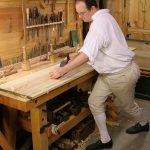We may receive a commission when you use our affiliate links. However, this does not impact our recommendations.
Here at Popular Woodworking, we design and build our own projects. We follow the same process most woodworkers do; we make some sketches, we talk about the project and we make working drawings to use in the shop. The drawings you see in the pages of the magazine start life as the drawings we use to build. I usually have my fingers somewhere in the illustration pie as we go from CAD drawings to the published page. I’ve used different CAD systems over the years, and this summer I’ve been learning Google SketchUp.

If you haven’t heard of SketchUp, you should check it out. It’s a free download and it’s the most user-friendly design software I have seen. If you’ve been considering using your computer for making shop drawings, it will be worth your time to give this a try. The price is right, there are good tutorials within the program and online, and there is even a “SketchUp for Dummies” book available. Over on the Woodworking Magazine blog, there is a SketchUp model one of our readers made for a workbench. If you download the software, you can then download the file and play around with it.
What you see at left is a 3-D model of a project I’ll be building for our December issue. This isn’t what the finished piece will look like, but it’s an accurate representation of the parts and how they fit together. With the way the program works, you can make parts, make joints on the parts, then put the whole thing together. You can keep things simple or you can let your obsessive/compulsive side run wild with intricate details and renderings.
The good news for us is that it makes our design process more like building. We can look at a piece from all angles and make sure everything works. The good news for you, the reader, is that we will be able to offer better drawings in the magazine, and a boatload of extra visual material online. For the November issue, there will be an online slide show that details how each part of our “I Can Do That” project goes together. We’ll be doing similar things for future issues, and we’re getting a little dizzy thinking about all the possibilities.
 How about a three-dimensional cutting list that shows each part of a project, or a model of a project that you can take apart and put back together? If drawings leave you wondering what a piece looks like from below or behind, you’ll be able to move around and take a look.
How about a three-dimensional cutting list that shows each part of a project, or a model of a project that you can take apart and put back together? If drawings leave you wondering what a piece looks like from below or behind, you’ll be able to move around and take a look.
At right is a closer-to-finished version of the first image. I had a lot of fun putting this together, and the time I spent in SketchUp will save me time when I get out to the shop. This is the first piece I’ve made that’s based on a pentagon, and there is some tricky joinery below the tabletop and where the shelf meets the legs. My first ideas on how to accomplish this looked good on paper, but wouldn’t work in 3-D. Using SketchUp allowed me to change my strategy before I cut any wood. (Although I did need to give some lapped dovetails a tap or two with a virtual mallet.)
So keep your eye on the magazine, our web site and the blog for more detailed, easier-to-understand and more useful project drawings. Let us know what you’d like to see by leaving a comment or sending an e-mail. Just for fun, the first reader to leave a comment correctly identifying this project by name and original maker will win a copy of all of our issues from 2006 on CD, and a copy of my latest book “Shop Drawings for Greene and Greene Furniture”
Here are some supplies and tools we find essential in our everyday work around the shop. We may receive a commission from sales referred by our links; however, we have carefully selected these products for their usefulness and quality.









ok, good!
share best site for you:
wow gold http://www.wowgolds.co.uk
广州电脑维修
We Have a Winner!
Nice work Rhett. E-mail me your mailing address and I’ll send out the CD and Book. Next time I’ll have to pick something even more obscure.
For the record, I don’t believe this piece ever had a model number. It dates from just before Gustav Stickley introduced his Craftsman line of furniture. There were two other "tea tables" along the same art nouveau lines that I have seen. Anybody know the names? (just for fun-the prize vault has been emptied for now)
Bob Lang
Mr. Lang,
The project shown looks like an early Gustav Stickley Poppy Table, although I cannot give you the number for the piece. If I remember correctly I saw one that was made out of Mahogany on an auction site once.